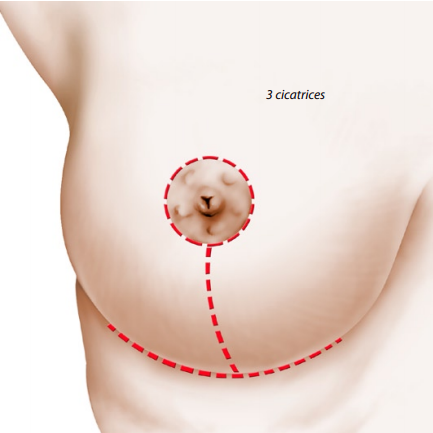DEFINITION :
Mammary hypertrophy is defined by a breast size too large, particularly in relation to the morphology of the patient.
This excess volume is generally associated to sagging breasts (ptosis) and sometimes to a certain degree of asymmetry.
The breast enlargement almost always involves a physical and functional impact (pain in the neck, shoulder and back discomfort for sports, clothing difficulties).
There is also a frequent significant psychological impact. These disorders justify the assumption by health insurance under certain conditions.
AIMS :
The surgery aims to reduce breast size, correction of ptosis and a possible asymmetry in order to get both breasts harmonious in themselves and in relation to the morphology of the patient (both breasts reduced and lifted, symmetrised and remodelled).
PRINCIPLES :
The procedure performs the removal of excess glandular tissue. It preserves a volume consistent with the silhouette of the patient and with their desires. This residual glandular volume is lifted, concentrated and redesigned.
Often these scars are shaped like an inverted T with three components: the peri-areolar ,the vertical and the horizontal.
Sometimes, particularly when the hypertrophy and ptosis are moderate, a method called “vertical”, that removes the transverse scar in the inframammary fold and reduce scarring to their periareolar and vertical components, could be used.
A subsequent pregnancy is of course possible as well as breastfeeding, but we recommend waiting at least six months after the intervention.
The risk of developing breast cancer is not increased by this intervention.
BEFORE THE OPERATION
A preoperative assessment is normally conducted as required.
The anaesthesiologist will be seen in consultation before surgery.
In addition to the usual pre-operative examinations, a radiological breast study is prescribed (mammography, ultrasound).
Smoking cessation is strongly recommended.
Stopping a possible oral contraceptive may be required.
No medication containing aspirin should only be taken within 10 days prior to surgery.
TYPE OF ANAESTHESIA AND HOSPITAL STAY
Type of anaesthesia:
This is general anaesthesia, during which you sleep completely.
Hospital stay:
Usually is required a hospitalization of one to three day
THE PROCEDURE
It exists some common basic principles to apply: the tissues removed are systematically sent to a specialized laboratory for examination under a microscope (histology).
At the end of surgery, a modelling bandage, with elastic bands, shaped like a bra, is made.
AFTER THE OPERATION: POSTOPERATIVE CARE AND FOLLOW-UP
The postoperative course is usually less painful, requiring only simple analgesics.
Swelling (edema) and ecchymosis (bruises) in the breasts, and a slight pain on elevation of the arms are frequently observed. The first dressing is removed after 24 hours and replaced by a bra ensuring good retention. It is recommended to wear the bra day and night during the first month.
THE RESULT :
It cannot be judged until one year after surgery: then the breasts have usually a smooth curve, are symmetric or very close to the symmetry, and natural looking.
It just needed to have the patience to wait the time required for the improvement of scars .

